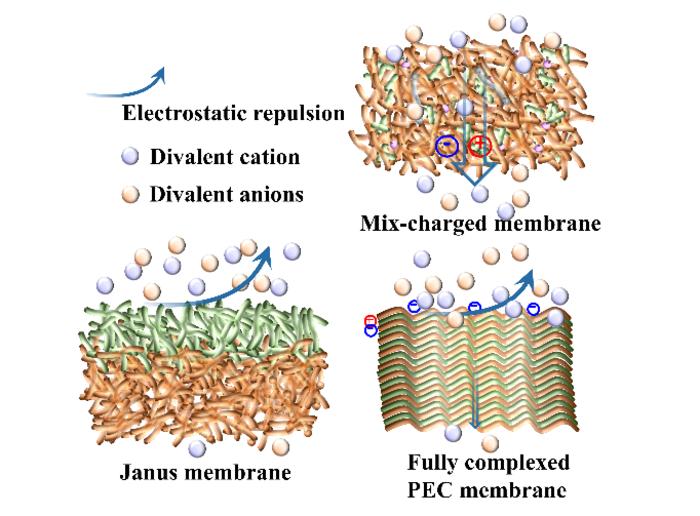A groundbreaking advancement in wastewater treatment has emerged from a research team at the Institute of Process Engineering (IPE), part of the Chinese Academy of Sciences. Led by the eminent Professor WAN Yinhua, the researchers have made significant strides in the development of a next-generation nanofiltration (NF) membrane characterized by a unique horizontal charge distribution. This innovative approach represents a pivotal shift in the technology used to address high-salinity organic wastewater, a challenge that has long plagued environmental and engineering disciplines.
The recently published study in the esteemed journal, Environmental Science & Technology, sheds light on the performance and capabilities of this novel membrane technology. The new NF membrane is not just another iteration in the long line of filtration advancements; it is specifically designed for wastewater treatment, exhibiting unparalleled capabilities in salt permeation and organic matter retention. Additionally, its antifouling properties add a crucial dimension to its operational effectiveness, making it a vital tool for industries managing high-salinity waste streams.
Efficiently managing and treating organic contaminants within high-salinity wastewater is not merely a technical hurdle; it is essential for promoting resource recovery and achieving zero discharge goals. Traditional NF membranes have been effective at separating organic compounds and monovalent salts. Still, their excessive rejection rates of divalent salts have posed significant limitations that inhibit optimal wastewater processing. The latest insights from this research team highlight the role of charge spatial distribution in overcoming these barriers, providing a comprehensive understanding of its impact on the transport behavior of salts through membranes.
The researchers have showcased a sophisticated method of developing this mix-charged NF membrane that integrates advanced techniques such as interfacial polymerization, polyester template etching, and solvent-induced polyamine intercalation. This unique combination not only influences the membrane’s charge characteristics but also establishes a near-electroneutral surface that is conducive to the efficient permeation of divalent salts. The engineering behind this membrane transcends simple creation; it introduces a paradigm shift that combines high charge density with structural integrity.
One of the standout features of this innovative membrane is its size-dependent "plug-in" modification, coupled with covalent crosslinking, which effectively reduces pore size. This reduction is critical for the enhanced rejection of small organic molecules, which are often problematic in conventional wastewater treatment processes. By targeting these small compounds, the membrane aids in minimizing their presence in the effluent, thus ensuring cleaner, more environmentally friendly discharge.
Moreover, the membrane demonstrates exceptional antifouling characteristics when interacting with both positively and negatively charged pollutants. This performance stems from the membrane’s unique charge distribution and its exceptionally smooth surface, which collectively inhibit the accumulation of foulants. Such characteristics are essential for maintaining permeability over extended operational periods and reducing maintenance needs, thereby enhancing the sustainability of wastewater treatment operations.
The empirical results from the research are compelling. The modified NF membrane achieves a remarkable salt permeation rate of 58.6% and a chemical oxygen demand (COD) rejection rate of 68.7% when applied to the treatment of high-salinity organic wastewater. These figures are among the best documented in scientific literature for NF membranes, signaling a noteworthy advancement in the field and providing a benchmark for future research and development efforts.
Prof. LUO Jianquan, who is the corresponding author of the study, elaborated on the significance of these results, emphasizing the membrane’s potential to transform wastewater treatment processes. He highlighted that the performance metrics achieved by this mixed-charge membrane position it as a formidable option for industries aiming to enhance their waste treatment methodologies and reduce their ecological footprint.
The implications of this research extend beyond mere technological advancement; they touch on critical environmental considerations and global sustainability efforts. As industries grapple with the challenges posed by high-salinity wastewater, solutions that enhance resource recovery become increasingly important. This breakthrough technology opens new avenues for sustainable practices, promoting both environmental stewardship and public health by reducing the detrimental impacts of wastewater on ecosystems.
In conclusion, the work conducted by Professor WAN Yinhua and his team represents a significant leap forward in the realm of wastewater treatment technologies. Their innovative approach to membrane design not only addresses the technical limitations faced by previous NF membranes but also sets the stage for future advancements in the field. As the complexities of wastewater treatment continue to evolve, technologies—like the one developed by this research team—will be indispensable in navigating the challenges ahead.
This pivotal advancement marks a new chapter in the quest for improved wastewater management strategies, emphasizing the vital role of academia in fostering innovation that bridges environmental needs with engineering excellence. As research in this domain progresses, the expectation is that further refinements and implementations of such technologies will facilitate the ongoing pursuit of sustainability and environmental responsibility across various industrial sectors.
Subject of Research: Development of a mix-charged nanofiltration membrane for treating high-salinity wastewater
Article Title: Mix-Charged Nanofiltration Membrane for Efficient Organic Removal from High-Salinity Wastewater: The Role of Charge Spatial Distribution
News Publication Date: 7-Jan-2025
Web References: DOI Link
References: Environmental Science & Technology
Image Credits: Image by REN Yuling
Keywords
Wastewater treatment, Nanofiltration membrane, High-salinity wastewater, Charge distribution, Antifouling properties, Sustainable practices, Resource recovery, Environmental technology.




